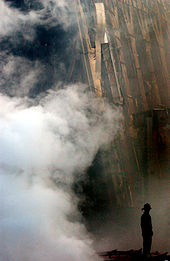Economic aftermath
The attacks had a significant economic impact on United States and world markets. The stock exchanges did not open on September 11 and remained closed until September 17. Reopening, the Dow Jones Industrial Average (DJIA) fell 684 points, or 7.1%, to 8921, a record-setting one-day point decline. By the end of the week, the DJIA had fallen 1,369.7 points (14.3%), at the time its largest one-week point drop in history. In 2001 dollars, U.S. stocks lost $1.4 trillion in valuation for the week.
In New York City, about 430,000 job-months and $2.8 billion dollars in wages were lost in the three months after the attacks. The economic effects were mainly on the economy's export sectors. The city's GDP was estimated to have declined by $27.3 billion for the last three months of 2001 and all of 2002. The U.S. government provided $11.2 billion in immediate assistance to the Government of New York City in September 2001, and $10.5 billion in early 2002 for economic development and infrastructure needs.
Also hurt were small businesses in Lower Manhattan near the World Trade Center, 18,000 of which were destroyed or displaced, resulting in lost jobs and their consequent wages. Assistance was provided by Small Business Administration loans, federal government Community Development Block Grants, and Economic Injury Disaster Loans. Some 31,900,000 square feet (2,960,000 m2) of Lower Manhattan office space was damaged or destroyed. Many wondered whether these jobs would return, and if the damaged tax base would recover. Studies of the economic effects of 9/11 show the Manhattan office real-estate market and office employment were less affected than first feared, because of the financial services industry's need for face-to-face interaction.
North American air space was closed for several days after the attacks and air travel decreased upon its reopening, leading to a nearly 20% cutback in air travel capacity, and exacerbating financial problems in the struggling U.S. airline industry.
Health effects

The thousands of tons of toxic debris resulting from the collapse of the Twin Towers contained more than 2,500 contaminants, including known carcinogens. Subsequent debilitating illnesses among rescue and recovery workers are said to be linked to exposure to these carcinogens. The Bush administration ordered the Environmental Protection Agency (EPA) to issue reassuring statements regarding air quality in the aftermath of the attacks, citing national security; however, the EPA did not determine that air quality had returned to pre-September 11 levels until June 2002.
Health effects also extended to residents, students, and office workers of Lower Manhattan and nearby Chinatown. Several deaths have been linked to the toxic dust, and the victims' names will be included in the World Trade Center memorial. There is also scientific speculation that exposure to various toxic products in the air may have negative effects on fetal development. A notable children's environmental health center is currently analyzing the children whose mothers were pregnant during the WTC collapse, and were living or working nearby. A study of rescue workers released in April 2010 found that all those studied had impaired lung functions, and that 30–40% were reporting little or no improvement in persistent symptoms that started within the first year of the attack.
Years after the attacks, legal disputes over the costs of illnesses related to the attacks were still in the court system. On October 17, 2006, a federal judge rejected New York City's refusal to pay for health costs for rescue workers, allowing for the possibility of numerous suits against the city. Government officials have been faulted for urging the public to return to lower Manhattan in the weeks shortly after the attacks. Christine Todd Whitman, administrator of the EPA in the aftermath of the attacks, was heavily criticized by a U.S. District Judge for incorrectly saying that the area was environmentally safe. Mayor Giuliani was criticized for urging financial industry personnel to return quickly to the greater Wall Street area. Some Americans, alarmed at the prospect of flying, instead traveled by car. This resulted in an estimated 1,595 more excess highway deaths in the ensuing year.
Government policies toward terrorism
As a result of the attacks, many governments across the world passed legislation to combat terrorism. In Germany, where several of the 9/11 terrorists had resided and taken advantage of that country's liberal asylum policies, two major anti-terrorism packages were enacted. The first removed legal loopholes that permitted terrorists to live and raise money in Germany. The second addressed the effectiveness and communication of intelligence and law enforcement. Canada passed the Canadian Anti-Terrorism Act, that nation's first anti-terrorism law. Great Britain passed the Anti-terrorism, Crime and Security Act 2001 and the Prevention of Terrorism Act 2005. Similarly, New Zealand enacted the Terrorism Suppression Act 2002.
In the United States, the Department of Homeland Security was created to coordinate domestic anti-terrorism efforts. The USA Patriot Act gave the federal government greater powers, including the authority to detain foreign terror suspects for a week without charge, to monitor telephone communications, e-mail, and Internet use by terror suspects, and to prosecute suspected terrorists without time restrictions. The Federal Aviation Administration ordered that airplane cockpits be reinforced to prevent terrorists gaining control of planes, and assigned sky marshals to flights. Further, the Aviation and Transportation Security Act made the federal government, rather than airports, responsible for airport security. The law created a federal security force to inspect passengers and luggage, causing long delays and concern over passenger privacy.